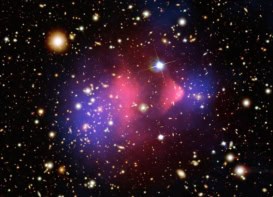
Annihilating dark matter at the heart of the Milky Way could account for signals detected by two space telescopes, according to a pair of US physicists. If true, the theory provides a new indirect measurement of one of astronomy’s most elusive entities. However, some physicists believe that we don’t know enough about the galactic core – or dark matter – to come to this conclusion.
In recent years the Fermi Gamma-ray Space Telescope has detected a flux of gamma-rays from the centre of our galaxy and the Wilkinson Microwave Anisotropy Probe (WMAP) has revealed a “haze” that also seems to envelop the Milky Way’s core. Now, Fermilab’s Dan Hooper and Tim Linden believe that dark matter can tie these two observations together.
Although dark matter is thought to make up more than 80% of all matter in the universe, it does not interact with electromagnetic radiation and its existence has been inferred from its gravitational effects on visible matter. The precise nature of dark matter is unknown and over the years many contenders have been put forward to account for it. The option currently favoured by most physicists, including Hooper, is as yet undiscovered weakly interacting massive particles (WIMPs).
Annihilating WIMPs
“If you get two WIMPS in the same place at the same time they interact in such a way that both get destroyed and liberate normal energy,” Hooper explains. He believes that this process supplies the gamma-rays observed by Fermi. The process would also create large numbers of electrons and positrons at the core of the Milky Way. Hooper and Linden believe that these particles interact with the galaxy’s magnetic field to produce a haze of radiation – and have modelled what they expect this radiation profile to look like. “Our model falls right on top of the WMAP data; they are in remarkably good agreement,” says Hooper.
Some researchers, however, believe it isn’t quite that simple. “The galactic centre is very hard to model; we don’t know much about it. There are also controversies about the nature of the Milky Way’s magnetic field,” explains Julien Lavalle, from the Institute of Theoretical Physics in Madrid. “This makes it very difficult to claim whether dark matter is responsible or not,” he adds.
There might also be problems with the mass of WIMPs used by Hooper and Linden. Their WIMPs weigh in at 7–9 GeV, which is in line with possible dark-matter signals seen in the ground-based CoGeNT and DAMA/LIBRA detectors. However, a heated debate has been raging over the veracity of these detections, as physicsworld.com reported last year (“Dark matter ‘no result’ comes under fire”). Indeed, the debate’s latest instalment has seen the CoGeNT and DAMA/LIBRA signals coming under increased fire from the XENON100 experiment (WIMP no-show casts a shadow over dark matter”).
Fighting his corner
However, Hooper is prepared to fight his corner. “I am still not entirely convinced by the XENON100 argument. There are reasons to think that due to the atomic properties of xenon [the element used in the detector], such a low energy WIMP interaction would leave no observable trace,” he argues.
But recent work (arXiv:1104.0679) by Martin Winkler and Rolf Kappl of the Technical University of Munich has put the matter under further scrutiny. If Hooper’s flavour of WIMPS exists then they should be efficiently captured by stars, including the Sun. Their annihilation in the Sun would produce energetic neutrinos detectable from Earth. Winkler and Kappl used the Super-Kamiokande neutrino detector to search for such high energy solar neutrinos. So far the search has yielded nothing. “We can constrain Hooper’s model substantially, but not rule it out,” Winkler told physicsworld.com.
Hooper still believes he is on the right track though. “Neither my paper nor anyone else’s is claiming a smoking gun for dark matter. But certainly, of all the signals that have come and gone over the years, it is this collection [Fermi, WMAP, CoGeNT, DAMA/LIBRA] that I find by far the most compelling,” he says.
Hooper and Linden’s findings are described in Phys. Rev. D 83 083517 and arXiv:1011.4520.



